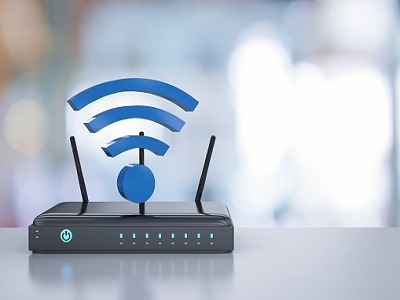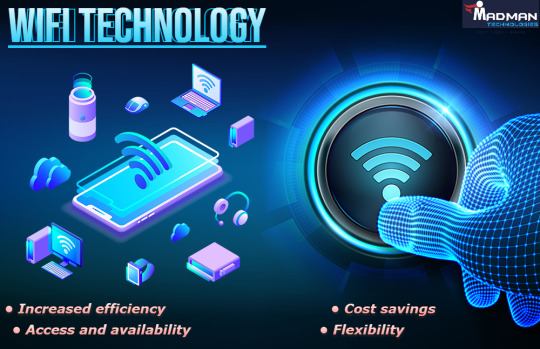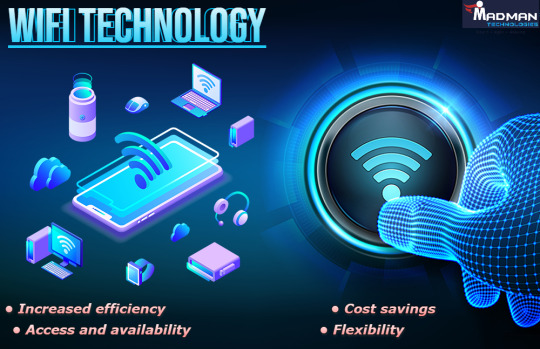#WirelessConnection
Explore tagged Tumblr posts
Text
Wireless Wonders: The Serendipitous Discovery of Wi-Fi

Wi-Fi has assimilated into our daily lives in the linked world of today. You may effortlessly surf the internet wirelessly no matter where you are, including at home, a coffee shop, or an airport. Have you ever thought about the origins of this amazing technology, though? The history of Wi-Fi's invention is one of inventiveness, creativity, and change in science.
Wi-Fi, which stands for "Wireless Fidelity," is a technology that enables wireless internet connectivity and communication between electronic devices. Its origins can be found in the 1940s when engineers and scientists were already investigating the potential of wireless communication. But Wi-Fi as we know it today didn't start to take shape until the late 20th century.
The history of radio waves and microwaves and the invention of Wi-Fi are closely related. Microwave technology was developed in the 1940s as a result of research into the properties of microwaves, particularly as they applied to radar systems used in World War II.
The field of computers developed during the 20th century. The necessity for wireless communication increased as a result of the development of the internet and the rising demand for linked products. To make this a reality, scientists and engineers started developing strategies.
Wi-Fi technology improved quickly during the following several years. It quickly became a common function in laptops and portable devices, and establishments and public areas started to provide Wi-Fi hotspots. The 1999-founded Wi-Fi Alliance was instrumental in establishing interoperability and security standards.
In conclusion, Wi-Fi was not created in a single "Eureka!" moment, but rather as the consequence of years of scientific inquiry, creative study, and unplanned exposure to microwave technology. We can now connect, work, and interact with one another with unprecedented ease thanks to Wi-Fi, which has since become a crucial aspect of our lives. This coincidental progression from radar and microwave systems to the wireless marvel of Wi-Fi exemplifies the amazing and unpredictably changing ways in which technology may advance and alter our world.
Visit our website at https://www.nextelle.net/.
#UnlimitedWireless#wirelessconnection#WirelessLAN#WirelessNetwork#LAN#Wifi#Internetconnection#Internetconnectivity#NextelleWireless
0 notes
Text
The Wonders of Wi-Fi Technology: Connecting the World Wirelessly
INTRODUCTION -
Staying connected is essential in today's fast-paced world for both personal and professional reasons. We have seen a dramatic change in how we use the internet and connect with one another thanks to Wi-Fi technology. We will delve into the wonders of Wi-Fi technology in this blog, looking at its background, advantages, modern developments, and effects on our daily life.
The Evolution of Wi-Fi Technology
With the publication of the IEEE 802.11 standard in 1997, Wi-Fi, short for Wireless Fidelity, made its debut. At first, it offered wireless connections with a constrained range and rather slow speeds. The performance, speed, and range of the technology have significantly increased over time thanks to ongoing developments and revisions.
Wi-Fi uses radio frequencies to link devices like smartphones, computers, smart home appliances, and more to the internet without the use of physical connections, often in the 2.4 GHz and 5 GHz bands. Wi-Fi's simplicity and convenience have completely changed how we access the online world.

BENEFITS OF WIFI TECHNOLOGY -
1) Wireless Connectivity : Wi-Fi technology's wireless nature, which frees us from the limitations of conventional connections, is its most obvious advantage. It offers customers the freedom to access the internet from any Wi-Fi-enabled location within the network's coverage area.
2) Conveyance and Mobility : We can access the internet while on the go it’s all because of the Wi-Fi. Anywhere there is a Wi-Fi hotspot, we can stay connected with our devices, enhancing productivity and communication whether we are at home, in a coffee shop, at the airport, or in a park.
3) Cost- Effective : Wire network installation can be expensive and time-consuming. Wi-Fi technology drastically lowers installation costs, making it a practical choice for both homes and businesses.
4) Broad Adoption : Most contemporary electronic products, from smartphones and laptops to smart TVs and home appliances, now come equipped with Wi-Fi as standard. This widespread use has consolidated the networking landscape, making life easier and fostering interoperability.
5) Enhanced Data Transfer Speeds : The adoption of the IEEE 802.11ac and 802.11ax standards, among other Wi-Fi technology advancements, has greatly accelerated data transfer rates. This allows for seamless streaming, quicker downloads, and more streamlined internet interactions.
CONLCUSION -
Wi-Fi technology has revolutionized how we connect, communicate, and interact with the digital world. Its broad use and ongoing improvements have made a variety of sectors and aspects of our daily life more convenient, productive, and innovative. Wi-Fi will likely play a bigger part in determining how networking and communication work in the future as technology develops.
Everybody wants their WIFI networks to be well-secured and disturbance free, and we at MADMAN TECHNOLOGIES aim at providing you with the best secured wireless connection or connections at campuses.
Think of the terms WPA, WEP, etc. These precautions are designed to protect your wireless internet and network connections from fraud and malicious intent and we assure you a safe and secured wireless connection.
For more information and details you may contact - madmantechnologies{dot}ai{at}gmail{dot}com
Contact details - 9625468776
#wifitechhnology#wirelessconnection#wifi#wifiservices#it services#information technology#technology#it products#internet#internet service provider#internet service
0 notes
Text
Revolutionizing IoT Development with Cutting-Edge Engineering

At MeshTek, we redefine IoT development services with a seamless fusion of hardware and software expertise. Our team specializes in embedded systems, wireless connectivity, and AI-driven IoT solutions, empowering manufacturers to create smart, scalable, and high-performing products. From microcontroller-based firmware design to advanced long-range mesh networking, we provide full-stack development, mobile app integration, and cloud-based analytics to accelerate speed-to-market while reducing costs. Partner with MeshTek to bring your IoT vision to life with innovation, precision, and reliability.
#IoTDevelopment#IoTSolutions#SmartTechnology#WirelessConnectivity#EmbeddedSystems#AIoT#FirmwareDesign#MeshNetworking#IoTPlatform#TechInnovation#IoTIntegration#SmartDevices#CloudIoT#FutureOfTech
1 note
·
View note
Text

Zealsound Wireless Lavalier Microphone for iPhone iPad Android with Charging Case, Lapel Mic for Vlog Interview Live Streaming. Offer with Choice Original price : USD 53.04 Now price : USD 19.09 Featured brands | Shipped within 72 hrs. Free shipping | Free returns. Check the Link for more info : https://s.click.aliexpress.com/e/_DBu0Mfv
Enhance your audio quality and capture crystal-clear sound with the Zealsound Wireless Lavalier Microphone. Designed for iPhone, iPad, and Android devices, this wireless lapel mic is the perfect companion for vlogs, interviews, live streaming, and more.
Say goodbye to tangled wires and limited mobility. The Zealsound Wireless Lavalier Microphone offers hassle-free connectivity, allowing you to move freely while recording or streaming. The wireless design provides a range of up to 50 feet, ensuring that you can capture audio without being tied down by cords.
#WirelessLavalierMic#ZealsoundMicrophone#VlogMicrophone#InterviewMicrophone#LiveStreamingMic#AudioQuality#MobileRecording#WirelessConnectivity
2 notes
·
View notes
Text

HPE Networking AP25 Instant On AP25 (RW) 4x4 Wi-Fi 6 AP R9B28A
Experience seamless connectivity with the HPE Networking AP25 Instant On AP25 (RW) 4x4 Wi-Fi 6 Access Point. Designed for fast, reliable wireless performance, it supports multiple devices with enhanced speed and coverage. Ideal for businesses seeking effortless network management and superior Wi-Fi 6 technology in a compact design.
For more information, Visit:https://newtrend.ae/product-category/aruba/ Live chat: +971 507542792
#HPENetworking#InstantOn#WiFi6#AccessPoint#WirelessConnectivity#FastInternet#ReliableNetwork#BusinessNetworking#NetworkManagement#TechSolutions#NewTrendAE#ArubaNetworking#SeamlessConnectivity#4x4WiFi6#CompactDesign#EnhancedCoverage#MultipleDevices#TechInnovation#SmartBusiness#UAEtech
0 notes
Text
Use the 15dBi Yagi Antenna to Boost Your 3G Signal!
Do you require a more robust 3G connection? See our 15dBi Yagi Antenna with 3-meter RG58 wire and N (M) Straight Connector. It is made to provide reliable reception, increased range, and excellent performance in any industrial or outdoor environment. Designed for long-lasting connectivity!
#EteilyAntenna#WirelessConnectivity#RuralSignalFix#AntennaExperts#YagiPower#IoTConnectivity#TechThatDelivers#TelecomEssentials#3GYagiAntenna
0 notes
Text
Distributed Antenna System (DAS) Market Future Trends: Innovations and Growth Opportunities in Wireless Connectivity
The Distributed Antenna System (DAS) market future trends indicate a dynamic evolution driven by growing demand for robust wireless connectivity in indoor and dense urban environments. DAS technology, designed to improve cellular coverage and capacity by distributing signals through multiple antennas, is increasingly vital as mobile data traffic soars and next-generation networks emerge.
This article explores the future trends shaping the DAS market, highlighting technological innovations, growing applications, regional developments, and strategic market shifts that are expected to define the industry’s growth in the coming years.

Rising Demand for Enhanced Indoor Connectivity
One of the core drivers for the DAS market is the growing necessity for reliable indoor wireless coverage. Traditional cell towers often fail to provide adequate signal penetration in large buildings, stadiums, airports, hospitals, and commercial complexes.
Trend Toward High-Capacity Venues: With the increase in events and gatherings, venues such as sports arenas, convention centers, and transportation hubs require enhanced connectivity solutions to support thousands of simultaneous users. DAS systems are evolving to offer higher capacity and seamless handoff capabilities.
Smart Building and Campus Deployments: The integration of DAS with smart building technologies is becoming a significant trend. Organizations aim to ensure uninterrupted connectivity for IoT devices, security systems, and mobile users within corporate campuses and educational institutions, pushing DAS demand.
Integration with 5G Networks
The rollout of 5G networks is one of the most transformative factors influencing DAS market future trends.
5G-Ready DAS Solutions: Future DAS deployments are being designed to support 5G’s higher frequency bands and massive MIMO (multiple-input multiple-output) technology. This enables ultra-fast data speeds, lower latency, and improved network reliability indoors.
Hybrid Networks Combining DAS and Small Cells: To maximize coverage and capacity, hybrid solutions combining DAS with small cell networks are gaining popularity. This strategic integration addresses challenges such as limited spectrum and network densification required by 5G.
Support for Network Slicing and Private Networks: As 5G enables network slicing and dedicated private networks, DAS systems are adapting to provide customizable coverage tailored to specific business or industrial needs, particularly in manufacturing, logistics, and healthcare sectors.
Increasing Adoption Across Diverse Industries
The DAS market is expanding beyond traditional telecommunications to serve multiple verticals, reflecting broadening application scenarios.
Healthcare: Hospitals require reliable, secure wireless connectivity for critical medical equipment, patient monitoring, and emergency communication. DAS ensures consistent signal quality in complex building layouts and underground areas.
Transportation: Airports, train stations, and metro systems increasingly deploy DAS to enhance passenger connectivity, operational communications, and security systems.
Retail and Hospitality: To meet customer expectations for seamless mobile experiences, malls, hotels, and resorts implement DAS to boost coverage and enable location-based services.
Industrial and Manufacturing: Factories and warehouses use DAS to support IoT devices, automated guided vehicles (AGVs), and real-time monitoring systems, enhancing operational efficiency and safety.
Technological Innovations Influencing Future Trends
Advancements in DAS technology are key to market growth and adapting to evolving connectivity needs.
Cloud-Based and Software-Defined DAS: Future DAS systems leverage cloud platforms and software-defined networking (SDN) to enable remote management, flexible configuration, and scalability. This reduces deployment costs and improves system responsiveness.
Energy Efficiency and Green Technologies: New DAS designs focus on reducing power consumption and integrating with renewable energy sources, aligning with global sustainability goals.
Improved Security Features: As DAS networks handle sensitive data and critical communications, enhanced cybersecurity measures are being incorporated, including encryption, intrusion detection, and compliance with regulatory standards.
Regional Market Trends and Growth Opportunities
Regional developments strongly influence DAS market future trends, driven by infrastructure investments and government policies.
North America Leading in Advanced Deployments: The U.S. and Canada are at the forefront of adopting 5G-ready DAS, supported by substantial investments in smart city projects and enterprise networks.
Asia-Pacific’s Rapid Urbanization and Connectivity Needs: Countries like China, India, Japan, and South Korea are witnessing rapid urban growth, increasing demand for indoor wireless solutions. Government initiatives promoting digital infrastructure boost DAS deployment.
Europe’s Focus on Public Safety and Regulatory Compliance: Europe emphasizes secure and resilient communication networks, including DAS for public safety, emergency response, and transport systems.
Market Challenges and Adaptations
Despite promising trends, the DAS market faces challenges that require strategic responses.
High Initial Deployment Costs: Although long-term benefits are substantial, upfront investments for DAS installation can be significant, particularly for small and medium-sized enterprises.
Complex Integration and Maintenance: Deploying DAS in existing buildings requires careful planning to avoid disruption. Continuous maintenance and upgrades to keep pace with evolving network standards are necessary.
Competition from Alternative Technologies: Small cells, Wi-Fi 6, and emerging wireless solutions pose competitive threats. DAS providers must differentiate through superior performance, scalability, and integration capabilities.
Strategic Outlook for DAS Market Growth
The future of the DAS market is promising, characterized by innovation and expanding use cases. Providers focusing on developing flexible, scalable, and cost-effective DAS solutions tailored for 5G and beyond will capture significant market share.
Collaboration with telecom operators, infrastructure companies, and enterprise customers will be critical to delivering customized deployments. Embracing software-defined technologies and cloud integration will also enhance service agility.
Conclusion
The Distributed Antenna System (DAS) market future trends showcase a rapidly evolving landscape shaped by 5G adoption, industry diversification, and technological breakthroughs. As wireless connectivity becomes indispensable across all facets of life and business, DAS will play a pivotal role in ensuring seamless, high-quality indoor coverage worldwide. Stakeholders who anticipate these trends and invest in innovation will position themselves at the forefront of this expanding market.
0 notes
Text
#IndustrialIoT#SmartMetering#WirelessConnectivity#IoTInnovation#DigitalInfrastructure#SmartCities#IndustrialAutomation#TechMilestone#powerelectronics#powermanagement#powersemiconductor
0 notes
Text



#netboon#TNCAdapter#CoaxialConnector#RFBulkheadAdapter#TNCFemaleToFemale#RFConnector#CoaxialAdapter#TelecomHardware#WirelessConnectivity#RFTools#AntennaConnector#BulkheadMount#HighFrequencyAdapter#SignalConnector#LabEquipment#TNCConnector
0 notes
Text
#Renesas Electronics#Bluetooth#IoT#WirelessConnectivity#SmartDevices#BLE#SoC#LowPowerDesign#Innovation#Timestech#electronicsnews#technologynews
0 notes
Text
𝗧𝗵𝗲 𝗙𝘂𝘁𝘂𝗿𝗲 𝗼𝗳 𝗖𝗼𝗻𝗻𝗲𝗰𝘁𝗶𝘃𝗶𝘁𝘆 𝗜𝘀 𝗛𝗲𝗿𝗲 – 𝗠𝗲𝘀𝗵 𝗪𝗶‑𝗙𝗶 𝗥𝗼𝘂𝘁𝗲𝗿𝘀 𝗟𝗲𝗮𝗱𝗶𝗻𝗴 𝘁𝗵𝗲 𝗪𝗮𝘆
Mesh Wi-Fi Router Market size is estimated to reach $3 billion by 2031, growing at a CAGR of 6.8% during the forecast period 2024-2031.
𝐃𝐨𝐰𝐧𝐥𝐨𝐚𝐝 𝐑𝐞𝐩𝐨𝐫𝐭 𝐒𝐚𝐦𝐩𝐥𝐞: 👉 https://lnkd.in/gDR9dkMu
𝐊𝐞𝐲 𝐓𝐫𝐞𝐧𝐝𝐬:
• 𝗦𝗲𝗮𝗺𝗹𝗲𝘀𝘀 𝗖𝗼𝘃𝗲𝗿𝗮𝗴𝗲 & 𝗦𝗰𝗮𝗹𝗮𝗯𝗶𝗹𝗶𝘁𝘆: Mesh #Wi‑Fi systems create a network of interconnected nodes, #ensuring whole‑home coverage and self‑healing connectivity.
• 𝗗𝗿𝗶𝘃𝗲𝗻 𝗯𝘆 𝗦𝗺𝗮𝗿𝘁 𝗛𝗼𝗺𝗲𝘀 & 𝗜𝗼𝗧: With the explosion of #smart devices and the shift to remote work, #demand for efficient, high‑performance routers is skyrocketing.
• 𝗜𝗻𝗻𝗼𝘃𝗮𝘁𝗶𝘃𝗲 𝗔𝗱𝘃𝗮𝗻𝗰𝗲𝗺𝗲𝗻𝘁𝘀: New mesh designs are #overcoming traditional dead‑spot issues, #offering easier setup and management for both residential and commercial users.
𝐆𝐞𝐭 𝐦𝐨𝐫𝐞 𝐢𝐧𝐟𝐨: https://lnkd.in/g_hmVd-y
𝐊𝐞𝐲 𝐏𝐥𝐚𝐲𝐞𝐫𝐬: Cisco • NETGEAR • Ubiquiti Inc. • Google • Amazon• Hewlett Packard Enterprise • Juniper Networks • Extreme Networks • CommScope
• ARRIS• Calix •Fortinet • Adtran • Linksys • Motorola Solutions •BT Group
• Virgin Media • EE • O2 (Telefónica UK) • Sierra Wireless • Rogers Communications • Bell • TELUS • Shaw Communications • Telmex • América Móvil • AT&T México • MEGACABLE • Totalplay
✨ (𝐂𝐫𝐞𝐝𝐢𝐭 𝐂𝐚𝐫𝐝 𝐃𝐢𝐬𝐜𝐨𝐮𝐧𝐭 𝐨𝐟 𝟏𝟎𝟎𝟎$ 𝐨𝐧 𝐚𝐥𝐥 𝐑𝐞𝐩𝐨𝐫𝐭 𝐏𝐮𝐫𝐜𝐡𝐚𝐬𝐞𝐬 | 𝐔𝐬𝐞 𝐂𝐨𝐝𝐞: 𝐅𝐋𝐀𝐓𝟏𝟎𝟎𝟎 𝐚𝐭 𝐜𝐡𝐞𝐜𝐤𝐨𝐮𝐭) https://lnkd.in/gHD_mqm6

0 notes
Text
Exploring the Diverse Types of Wireless Connectivity

Wireless communication has become the new standard in a world where wires and cables are fast becoming obsolete. Wireless technologies have taken over as the mainstay of modern communication, from our smartphones and laptops to smart home appliances and industrial uses.
The most popular type of wireless communication is probably Wi-Fi. It makes it possible for devices to connect to local networks and the internet without using physical wires. The most widely used frequency bands for Wi-Fi are the 2.4 GHz and 5 GHz bands. We remain linked thanks to technology at home, in coffee shops, airports, and many other public places.
Our smartphones and other mobile devices are connected wirelessly by cellular networks, such as 3G, 4G, and the more recent 5G. We may use these networks to access the internet, send SMS, and make calls while we are on the move. The switch to 5G promises to be even quicker.
Bluetooth is a wireless short-range technology that makes it easier to connect peripherals like speakers, headphones, and headphones to smartphones, tablets, and PCs. Bluetooth is ideal for IoT applications and personal area networks since it runs on a low-power, short-range protocol.
Designed for low-power, short-range devices like smart home sensors and controls, Zigbee is a wireless communication standard. It is frequently utilized in IoT applications and home automation systems where extended battery life and dependability are crucial.
NFC is a wireless short-range technology used for device pairing, data transfer, and contactless payments. Everything from credit cards to public transit systems use this technology, which is the brains behind services like Apple Pay and Google Wallet.
RFID technology employs radio waves for wireless communication to identify and track items. It is frequently used in access control systems, supply chain management, and even as a way to track luggage and pets.
A wireless protocol called LoRa was created for low-power, long-range applications. It is frequently utilized in Internet of Things (IoT) devices that must interact across long distances, including those used in environmental monitoring and agriculture.
Devices or sites in remote locations without access to terrestrial networks can be connected using satellite communication. worldwide telecommunications, such as television broadcasts, GPS systems, and worldwide internet access in remote areas, depend on this technology.
Infrared communication is still utilized, albeit less frequently than other wireless technologies in some niche applications. This line-of-sight technology is used in IR remote controls for TVs, projectors, and some data transfer techniques.
UWB is a new technology that is renowned for both its high bandwidth and low energy usage. It is being used more and more in programs like secure device authentication, accurate indoor positioning, and real-time location systems.
In conclusion, each technology in the wide and ever-evolving field of wireless communication is created to satisfy particular demands and use cases. From the widespread use of cellular networks and Wi-Fi to the specialized uses of RFID, Zigbee, and UWB, wireless technologies continue to change how we work and live. Understanding these many forms of wireless connectivity is essential to making educated decisions and realizing the full potential of our interconnected future as our world gets more and more connected.
Visit our website at https://www.nextelle.net/.
#UnlimitedWireless#wirelessconnection#WirelessLAN#WirelessNetwork#LAN#Wifi#Internetconnection#Internetconnectivity#NextelleWireless
0 notes
Text
WIFI TECHNOLOGY
Wifi has numerous offers and focal points which make life simple for individuals and the working culture simpler to do long and long forms in least time. There's no denying that installing and employing a WiFi organize is straightforward. Indeed the larger part of businesses introduce remote LAN cards on their computers some time recently advertising them to customers.
SOME ADVANTAGES OF WIFI ARE:-
Practicality:- Multiple people can join a wireless network at the same time. Through the router or a hotspot technology, connections can be established in a matter of seconds without any setups.
Movement:- With WiFi, especially on mobile devices, you may complete your normal tasks from any location as long as you are within range of a Wifi Access Point.
Productivity:- With the help of a WiFi network, employees of a company can do their given responsibilities wherever they are.

Everyone wants their wireless networks to be secure and quiet, and MADMAN TECHNOLOGIES strives to offer you the most secure wireless connection possible on college campuses.Think of words like WPA and WEP. These precautions are designed to protect your wireless internet and network connections from fraud and malicious intent and we assure you a safe and secured wireless connection.
For more information and details you may contact - madmantechnologies{dot}ai{at}gmail{dot}com
Contact details - XIVIIIVIVVIVIIIVIIVIIVI
#wifiservices#wifitechhnology#wifi#wirelessconnection#information technology#technology#information#it services#it products
0 notes
Text
MeshTek: Pioneering the Future of Smart IoT Connectivity

MeshTek revolutionizes IoT with its advanced Bluetooth Mesh technology, enabling seamless, scalable, and energy-efficient smart automation solutions. From smart lighting to industrial automation, our cutting-edge platform ensures long-range connectivity, AI-driven optimization, and secure communication. Elevate your IoT ecosystem with MeshTek’s next-gen innovation.
#MeshTek#IoT#BluetoothMesh#SmartAutomation#IndustrialIoT#SmartLighting#AI#ConnectedTechnology#IoTSolutions#WirelessConnectivity#Innovation#Automation#TechSolutions#FutureTech#SmartBuildings#BLEMesh#SmartInfrastructure
1 note
·
View note
Text
6G Connectivity: The Next Leap in Wireless Communication
🚀 The future of wireless technology is here, 6G is set to redefine connectivity with ultra-fast speeds, near-zero latency, and groundbreaking applications. While 5G is still being deployed worldwide, researchers and tech giants are already preparing for the next generation of wireless communication: 6G networks. What will 6G bring? ✅ Speeds up to 100 times faster than 5G✅ Ultra-low latency for…
0 notes
Text

Huawei AP361 Access Point Dubai The Huawei AP361 Dubai is an advanced indoor Wi-Fi 6 (802.11ax) access point designed to deliver high-performance wireless connectivity. It operates on both the 2.4 GHz (2×2) and 5 GHz (2×2) frequency bands simultaneously, ensuring robust and reliable service.
1 x GE electrical port
Working modes: Fit, Fat, and cloud management
Working simultaneously on the 2.4 GHz (2×2) + 5 GHz (2×2) frequency bands
For more information, Visit:https://newtrend.ae/product-category/huawei/huawei-authorized-partner-dubai-uae/ Live chat: +971 507542792
#HuaweiAP361#WiFi6#AccessPointDubai#HuaweiUAE#IndoorWiFi#WirelessConnectivity#NewTrendUAE#TechDubai#NetworkingSolutions#DualBandWiFi#CloudManagedAP#SmartNetworking#HuaweiPartnerUAE#WiFiExperts#ITSolutionsDubai#NextGenWiFi#ReliableConnectivity#EnterpriseWiFi#WiFiDubai#NewTrendNetworking#HuaweiSolutions
0 notes